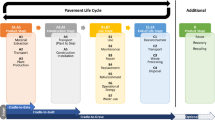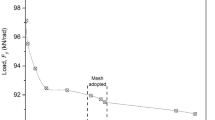Abstract
In this study, extensive large-scale model pavement experiments consisting of a total of twenty-one pavement sections overlying different subgrade conditions (poor to firm) were conducted to determine the traffic benefit ratio (TBR). TBR is quantified as the ratio of a cumulative number of load cycles to reach a defined deformation/failure state in the reinforced section to that of the unreinforced section with the same pavement geometry and material constitutions. Biaxial geogrids made up of polyester and polypropylene of varying tensile strengths were considered. The controlled experimentation was carried out in a large-sized test chamber of dimensions equal to 1.5 m in length, 1.5 m in width, and 1.0 m in depth. To simulate the wheel loading on the pavement in a real field condition, repetitive loading was applied in the form of haversine loading using a linear actuator system of 100 kN capacity. Based on the studies, geogrid placed at one-third thickness of the base layer was found to be the optimal depth of reinforcement. TBRs of the reinforced pavement were found to range from 1 to 52. The study, however, recommends the use of TBR ranging from 1.5 to 4 for a conservative design. Finally, the TBR-based design of pavements was illustrated through a worked-out example for given input parameters. The thickness of aggregate layers was found to reduce by 7.5–29% for the range of California bearing ratios and TBRs considered in this study.













Similar content being viewed by others
Data Availability
All data, models, and code generated or used during the study appear in the submitted article.
Abbreviations
- AASHTO:
-
American Association of State Highway and Transportation Officials
- CBR:
-
California bearing ratio
- CPD:
-
Cumulative permanent deformation
- COV:
-
Coefficient of variation
- DBM:
-
Dense bituminous macadam
- ESAL:
-
Equivalent single-axle load
- IRC:
-
Indian Roads Congress
- LCR:
-
Layer coefficient ratio
- LWD:
-
Lightweight deflectometer
- MD:
-
Machine direction
- MIF:
-
Modulus improvement factor
- MORTH:
-
Ministry of Road Transport and Highways
- MPT:
-
Multi Purpose Test Ware
- msa:
-
Million standard axles
- PET:
-
Polyester
- PP:
-
Polypropylene
- TBR:
-
Traffic benefit ratio
- XMD:
-
Cross-machine direction
References
AASHTO: Guide for design of pavement structures. American Association of State Highway and Transportation Officials, Washington, DC (1993)
AASHTO-R50: Standard practice for geosynthetic reinforcement of the aggregate base course of flexible pavement structures Thirty-first edition. American Association of State Highway and Transportation Officials, Washington, D.C (2009)
Abu-Farsakh, M.Y., Akond, I., Chen, Q.: Evaluating the performance of geosynthetic-reinforced unpaved roads using plate load tests. Int. J. Pavement Eng. 17(10), 901–912 (2016). https://doi.org/10.1080/10298436.2015.1031131
AI MS-2.: Asphalt mix design methods. In Abdulhaq Hadi Abedali (Ed.), Seventh edition of manual series-2, Asphalt Institute (2014)
Al-Qadi, I.L., Dessouky, S., Kwon, J., Tutumluer, E.: Geogrid-reinforced low-volume flexible pavements: pavement response and geogrid optimal location. J. Transp. Eng. 138(9), 1083–1090 (2012). https://doi.org/10.1061/(asce)te.1943-5436.0000409
ASTM D2487: Standard practice for classification of soils for engineering purposes (unified soil classification system). American Society for Testing and Materials ASTM International, West Conshohocken, PA (2017)
ASTM D6637: Standard test method for determining tensile properties of geogrids by the single or multi-rib tensile method. American Society for Testing and Materials ASTM International, West Conshohocken, PA (2015)
ASTM D698: Standard test methods for laboratory compaction characteristics of soil using standard effort (12 400 ft-lbf/ft3 (600 kN-m/m3). American Society for Testing and Materials ASTM International, West Conshohocken, PA (2012)
ASTM E2583: Standard test method for measuring deflections with a light weight deflectometer (LWD). American Society for Testing and Materials ASTM International, West Conshohocken, PA (2020)
Baadiga, R., Balunaini, U., Saride, S., Madhira, R.M.: Influence of geogrid properties on rutting and stress distribution in reinforced flexible pavements under repetitive wheel loading. J. Mater. Civ. Eng. (2021). https://doi.org/10.1061/(ASCE)MT.1943-5533.0003972
Berg, Ryan R., Christopher, Barry R., Perkins Steven.: Geosynthetic reinforcement of the aggregate base/subbase courses of pavement structures, Geosynthetic Materials Association White Paper II, Roseville, Minnesota, USA (2000)
Cancelli, A. and Montanelli, F.: In-ground test for geosynthetic reinforced flexible paved roads. Proc. Conf. Geosynthetics 1999, Boston, MA, USA, Vol. 2, pp. 863-878 (1999)
Cancelli, A., Montanelli, F., Rimoldi, P. and Zhao, A.: Full scale laboratory testing on geosynthetics reinforced paved roads. Proc. Int. Symp. Earth Reinf., Fukuoka/Kyushu, Japan, November, Balkema, 573-578 (1996)
Chen, Q., Abu-Farsakh, M., Tao, M.: Laboratory evaluation of geogrid base reinforcement and corresponding instrumentation program. Geotech. Test. J 32(6), 516–525 (2009). https://doi.org/10.1520/GTJ102277
Chen, Q., Hanandeh, S., Abu-Farsakh, M., Mohammad, L.: Performance evaluation of full-scale geosynthetic reinforced flexible pavement. Geosynth. Int. 25(1), 26–36 (2017). https://doi.org/10.1680/jgein.17.00031
Collin, J.G., Kinney, T.C., Fu, X.: Full scale highway load test of flexible pavement systems with geogrid reinforced base courses. Geosynth. Int. 3(4), 537–549 (1996). https://doi.org/10.1680/gein.3.0074
Goud, G.N., Umashankar, B.: Flexible pavement reinforced with planar reinforcement-experimental study. Indian Road Congress. Indian Highways. Journal of The Indian Roads Congress.11–18 (2019)
Goud, G.N., Sasanka, M.S., Umashankar, B., Sireesh., S., Madhav, M.R.: Design and sustainability aspects of geogrid-reinforced flexible pavements-an Indian perspective. Front. Built Environ., 6 (71) (2020a). https://doi.org/10.3389/fbuil.2020.00071
Goud, G.N., Ramu, B., Umashankar, B., Sireesh, S., Madhav, M.R.: Evaluation of layer coefficient ratios for geogrid-reinforced bases of flexible pavements. J. Road Mater. Pavement Des. 1–12 (2020b). https://doi.org/10.1080/14680629.2020.1812424
Han, J.: Design of planar geosynthetic-improved unpaved and paved roads. Pavement Geotech. Eng. Transp.31–41 (2013). https://doi.org/10.1061/9780784412817.003
Han, J.: Principles and practice of ground improvement, First Edition, John Wiley & Sons, Inc., Hoboken, New Jersey, USA (2015)
IRC:37: Guidelines for the design of flexible pavements, 3rd edn. Indian Road Congress, New Delhi (2012)
Kwon, J., Tutumluer, E.: Geogrid base reinforcement with aggregate interlock and modeling of associated stiffness enhancement in mechanistic pavement analysis. Transp. Res. Rec., J. Transp. Res. Board 2116(1), 85–95 (2009). https://doi.org/10.3141/2116-12
Montanelli, F., Zhao, A., Rimoldi, P.: Geosynthetic-reinforced pavement system: testing & design. In: Paulson, J.N. (ed.) Geosynth. 1997 Proc., Long Beach, CA. vol. 2. Industrial Fabr 619–632. Association Int, Roseville, MN (1997)
MORTH: Specifications for road and bridge works 5. Ministry of Road Transport and Highways, New Delhi (2013)
Perkins, S.W.: Mechanical response of geosynthetic-reinforced flexible pavements. Geosynth. Int. 6(5), 347–382 (1999). https://doi.org/10.1680/gein.6.0157
Perkins, S.W., Ismeik, M.: A synthesis and evaluation of geosynthetic-reinforced base layers in flexible pavements: part I. Geosynth. Int. 4(6), 549–604 (1997a). https://doi.org/10.1680/gein.4.0106
Perkins, S.W., Ismeik, M.: A synthesis and evaluation of geosynthetic-reinforced base layers in flexible pavements: part II. Geosynth. Int. 4(6), 605–621 (1997b). https://doi.org/10.1680/gein.4.0107
Perkins, S. W.: Geosynthetic reinforcement of flexible pavements: laboratory based pavement test sections. U.S. Department of Transportation, Federal Highway Administration, Washington, DC, Final Report: FHWA/MT-99–001/8138, 1–110 (1999b)
Robinson, W.J., Tingle, J.S., Norwood, G.J., Wayne, M.H., Kwon, J.: Performance of multi-axial geogrid stabilized flexible pavements. Proc. Inst. Civ. Eng. Ground Improv. 171(4), 185–194 (2018). https://doi.org/10.1680/jgrim.17.00032
Saride, S., Baadiga, R.: New layer coefficients for geogrid-reinforced pavement bases. Indian Geotech. J. 51, 182–196 (2021). https://doi.org/10.1007/s40098-020-00484-6
Tang, X., Chehab, G.R., Palomino, A.: Evaluation of geogrids for stabilising weak pavement subgrade. Int. J. Pavement Eng. 9(6), 413–429 (2008). https://doi.org/10.1080/10298430802279827
Tex-621-J.: Testing geogrids, Texas Department of Transportation. Technical Report 08/99–12/07, Texas, USA (2007)
Underhill, A.E., Billing, D.E.: The California bearing ratio test on loess. Nat. Publ. Group 209, 1289–1290 (1996). https://doi.org/10.1038/2091289c0
Webster, S. L.: Geogrid reinforced base courses for flexible pavements for light aircraft: test section construction, behavior under traffic, laboratory tests and design criteria. US Army Corps of Eng. Technical Report, GL-93–6, USAE, Waterways Experiment Station, Vicksburg, Mississippi, USA(1993)
Zornberg, J.G., Prozzi, J., Gupta, R., Luo, R., McCartney, J.S., Ferreira, J.Z., Nogueira, C.: Validating mechanisms in geosynthetic reinforced pavements. Federal Highway Administration, Technical Report No. FHWA/TX-08/0–4829–1, Project 0-4829, Center for Transportation Research, Austin, Texas, USA (2008)
Acknowledgements
The authors thank M/s. TechFab India Pvt. Ltd. and M/s. Strata Geosystems India Pvt. Ltd. for readily providing the geogrids.
Funding
This work was carried out as part of the research project funded by the National Highways Authority of India (NHAI) under the grant no: NHAI/TIC/R&D/108/2016.
Author information
Authors and Affiliations
Contributions
Ramu Baadiga: conceptualization formulation, methodology, data acquisition, examination, analysis, and original manuscript writing. Umashankar Balunaini: conceptualization formulation, project supervision, resource allocation, methodology, visualization, writing the original manuscript, and editing. Sireesh Saride: conceptualization formulation, supervision, and manuscript review. Madhav Madhira R: conceptualization, project administration, visualization, manuscript review, and editing.
Corresponding author
Ethics declarations
Conflict of Interest
The authors declare no competing interests.
Additional information
Publisher's Note
Springer Nature remains neutral with regard to jurisdictional claims in published maps and institutional affiliations.
Rights and permissions
About this article
Cite this article
Baadiga, R., Balunaini, U., Saride, S. et al. Effect of Geogrid Type and Subgrade Strength on the Traffic Benefit Ratio of Flexible Pavements. Transp. Infrastruct. Geotech. 10, 180–210 (2023). https://doi.org/10.1007/s40515-021-00203-5
Accepted:
Published:
Issue Date:
DOI: https://doi.org/10.1007/s40515-021-00203-5




